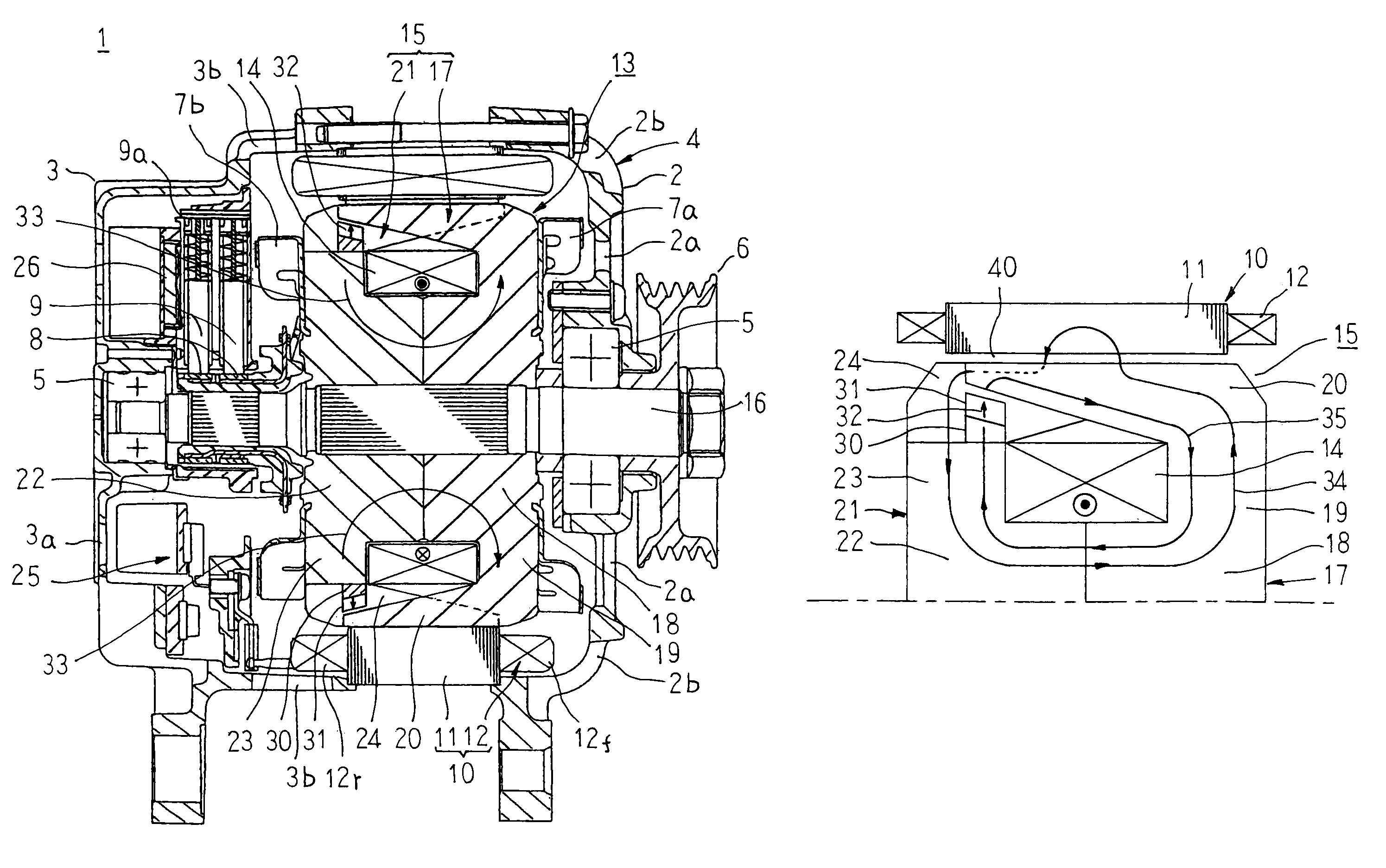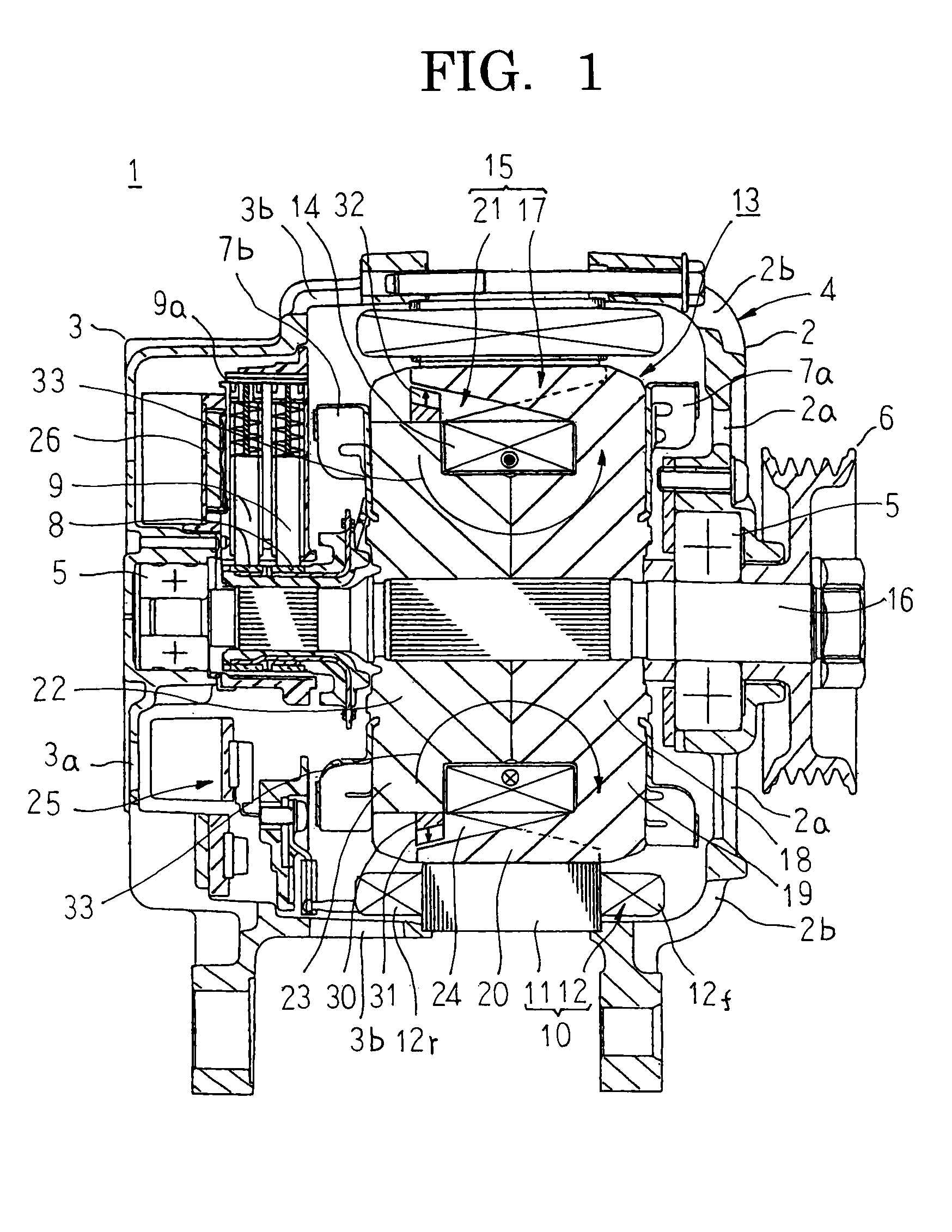Dynamoelectric machine
a dynamoelectric machine and dynamoelectric technology, applied in the direction of magnetic circuit rotating parts, magnetic circuit shape/form/construction, cooling/ventilation arrangement, etc., can solve the problems of invariably increasing the size of alternators, so as to reduce interference noise between cooling airflows, increase the reliability of permanent magnets, and increase the cooling
- Summary
- Abstract
- Description
- Claims
- Application Information
AI Technical Summary
Benefits of technology
Problems solved by technology
Method used
Image
Examples
embodiment 1
[0027]FIG. 1 is a cross section that schematically shows an automotive alternator according to Embodiment 1 of the present invention, FIG. 2 is a perspective of a rotor that can be used in the automotive alternator according to Embodiment 1 of the present invention, and FIG. 3 is a schematic diagram for explaining flow of magnetic flux in the automotive alternator according to Embodiment 1 of the present invention.
[0028]In FIGS. 1 and 2, an automotive alternator 1 includes: a case 4 that is constituted by a front bracket 2 and a rear bracket 3 that are each made of aluminum so as to have an approximate cup shape; a rotor 13 that is rotatably disposed inside the case 4 such that a shaft 16 is supported by means of bearings 5 in the case 4; a pulley 6 that is fixed to an end portion of the shaft 16 that projects outward at a front end of the case 4; first and second cooling fans 7a and 7b that are fixed to two axial end surfaces of the rotor 13; a stator 10 that is fixed to the case 4...
embodiment 2
[0063]In Embodiment 1 above, the directions of magnetization 32 of the permanent magnets 31 are aligned in a radial direction, but in Embodiment 2, directions of magnetization 32 of permanent magnets 31 are directed toward inner circumferential surfaces near tip ends of first claw-shaped magnetic pole portions 20 so as to be inclined toward a field coil 14 relative to the radial direction, as shown in FIG. 6. Moreover, the rest of this embodiment is configured in a similar manner to Embodiment 1 above.
[0064]In FIG. 6, the permanent magnets 31 are formed so as to have parallelogrammatic cross sections, and are fixed to upper surfaces of the magnet seat 30 so as to face the inner circumferential surfaces near the tip ends of the first claw-shaped magnetic pole portions 20 using adhesive, etc., so as to be magnetically connected. The upper surfaces of the permanent magnets 31 are approximately parallel to the inner circumferential surfaces of the first claw-shaped magnetic pole portion...
embodiment 3
[0072]In Embodiment 1 above, the permanent magnets 31 are held on the magnet seat 30 that is disposed on the second yoke portion 23, but in Embodiment 3, permanent magnets 38 are held on a magnet seat 37 that is disposed on a first yoke portion 19, as shown in FIG. 7.
[0073]Moreover, the rest of this embodiment is configured in a similar manner to Embodiment 1 above.
[0074]In FIG. 7, the magnet seat 37 is prepared by a cold forging manufacturing method using a magnetic material such as a low carbon steel such as S10C, for example. The magnet seat 37 is fixed onto outer circumferential surfaces of the first yoke portion 19 that face inner circumferential surfaces near tip ends of each of the second claw-shaped magnetic pole portions 24 using adhesive, etc., so as to be magnetically connected. Upper surfaces of the magnet seat 37 are formed so as to be approximately parallel to the inner circumferential surfaces of the second claw-shaped magnetic pole portions 24. In addition, the perma...
PUM
 Login to View More
Login to View More Abstract
Description
Claims
Application Information
 Login to View More
Login to View More - R&D
- Intellectual Property
- Life Sciences
- Materials
- Tech Scout
- Unparalleled Data Quality
- Higher Quality Content
- 60% Fewer Hallucinations
Browse by: Latest US Patents, China's latest patents, Technical Efficacy Thesaurus, Application Domain, Technology Topic, Popular Technical Reports.
© 2025 PatSnap. All rights reserved.Legal|Privacy policy|Modern Slavery Act Transparency Statement|Sitemap|About US| Contact US: help@patsnap.com



